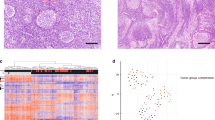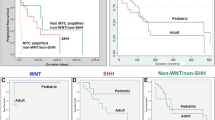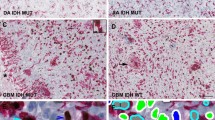Abstract
We previously reported observing GLI3 in medulloblastomas expressing neuronal markers (NM) and/or glial fibrillary acidic protein (GFAP). Furthermore, patients with medulloblastomas expressing NM or GFAP tended to show favorable or poor prognosis, respectively. In the present study, we focused on the role of topoisomerase IIβ (TOP2β) as a possible regulator for neuronal differentiation in medulloblastomas and examined the pathological roles of GLI3, NM, GFAP, and TOP2β expressions in a larger population. We divided 124 medulloblastomas into three groups (NM−/GFAP−, NM +/GFAP−, and GFAP +) based on their immunoreactivity (IR) against NM and GFAP. The relationship among GLI3, NM, GFAP, and TOP2β was evaluated using fluorescent immunostaining and a publicly available single-cell RNA sequencing dataset. In total, 87, 30, and 7 medulloblastomas were classified as NM−/GFAP−, NM + /GFAP−, and GFAP +, and showed intermediate, good, and poor prognoses, respectively. GLI3-IR was frequently observed in NM +/GFAP− and GFAP + , and TOP2β-IR was frequently observed only in NM +/GFAP− medulloblastomas. In fluorescent immunostaining, TOP2β-IR was mostly co-localized with NeuN-IR but not with GFAP-IR. In single-cell RNA sequencing, TOP2β expression was elevated in CMAS/DCX-positive, but not in GFAP-positive, cells. NM-IR and GFAP-IR are important for estimating the prognosis of patients with medulloblastoma; hence they should be assessed in clinical practice.




Similar content being viewed by others
References
Northcott PA, Korshunov A, Witt H et al (2011) Medulloblastoma comprises four distinct molecular variants. J Clin Oncol 29:1408–1414
Cavalli FMG, Remke M, Rampasek L et al (2017) Intertumoral heterogeneity within medulloblastoma subgroups. Cancer Cell 31:737-754.e736
Brown HG, Kepner JL, Perlman EJ et al (2000) “Large cell/anaplastic” medulloblastomas: a Pediatric Oncology Group Study. J Neuropathol Exp Neurol 59:857–865
Eberhart CG, Kepner JL, Goldthwaite PT et al (2002) Histopathologic grading of medulloblastomas: a Pediatric Oncology Group study. Cancer 94:552–560
Giangaspero F, Rigobello L, Badiali M et al (1992) Large-cell medulloblastomas. A distinct variant with highly aggressive behavior. Am J Surg Pathol 16:687–693
Giangaspero F, Wellek S, Masuoka J et al (2006) Stratification of medulloblastoma on the basis of histopathological grading. Acta Neuropathol 112:5–12
Lamont JM, Mcmanamy CS, Pearson AD et al (2004) Combined histopathological and molecular cytogenetic stratification of medulloblastoma patients. Clin Cancer Res 10:5482–5493
Mcmanamy CS, Lamont JM, Taylor RE et al (2003) Morphophenotypic variation predicts clinical behavior in childhood non-desmoplastic medulloblastomas. J Neuropathol Exp Neurol 62:627–632
Giangaspero F, Perilongo G, Fondelli MP et al (1999) Medulloblastoma with extensive nodularity: a variant with favorable prognosis. J Neurosurg 91:971–977
Suresh TN, Santosh V, Yasha TC et al (2004) Medulloblastoma with extensive nodularity: a variant occurring in the very young-clinicopathological and immunohistochemical study of four cases. Childs Nerv Syst 20:55–60
Miyahara H, Natsumeda M, Yoshimura J et al (2014) Neuronal differentiation associated with Gli3 expression predicts favorable outcome for patients with medulloblastoma. Neuropathology 34:1–10
Tsutsui KM, Sano K, Hosoya O et al (2006) Expression dynamics and functional implications of DNA topoisomerase II beta in the brain. Anat Sci Int 81:156–163
Kenig S, Faoro V, Bourkoula E et al (2016) Topoisomerase IIbeta mediates the resistance of glioblastoma stem cells to replication stress-inducing drugs. Cancer Cell Int 16:58
Chen J, Zhao J, Zhou X et al (2017) Immunohistochemical investigation of topoIIbeta, H3K27me3 and JMJD3 expressions in medulloblastoma. Pathol Res Pract 213:975–981
Natsumeda M, Aoki H, Miyahara H et al (2011) Induction of autophagy in temozolomide treated malignant gliomas. Neuropathology 31:486–493
Ellison DW, Dalton J, Kocak M et al (2011) Medulloblastoma: clinicopathological correlates of SHH, WNT, and non-SHH/WNT molecular subgroups. Acta Neuropathol 121:381–396
Kaur K, Kakkar A, Kumar A et al (2016) Integrating molecular subclassification of medulloblastomas into routine clinical practice: a simplified approach. Brain Pathol 26:334–343
Burger PC, Grahmann FC, Bliestle A et al (1987) Differentiation in the medulloblastoma. A histological and immunohistochemical study. Acta Neuropathol 73:115–123
Northcott PA, Shih DJ, Remke M et al (2012) Rapid, reliable, and reproducible molecular sub-grouping of clinical medulloblastoma samples. Acta Neuropathol 123:615–626
Gomez S, Garrido-Garcia A, Garcia-Gerique L et al (2018) A novel method for rapid molecular subgrouping of medulloblastoma. Clin Cancer Res 24:1355–1363
Hovestadt V, Smith KS, Bihannic L et al (2019) Resolving medulloblastoma cellular architecture by single-cell genomics. Nature 572:74–79
Tirosh I, Venteicher AS, Hebert C et al (2016) Single-cell RNA-seq supports a developmental hierarchy in human oligodendroglioma. Nature 539:309–313
Polkinghorn WR, Tarbell NJ (2007) Medulloblastoma: tumorigenesis, current clinical paradigm, and efforts to improve risk stratification. Nat Clin Pract Oncol 4:295–304
Ma Q, Chen Z, Del Barco BI et al (1998) Neurogenin1 is essential for the determination of neuronal precursors for proximal cranial sensory ganglia. Neuron 20:469–482
Sun Y, Nadal-Vicens M, Misono S et al (2001) Neurogenin promotes neurogenesis and inhibits glial differentiation by independent mechanisms. Cell 104:365–376
Tiwari VK, Burger L, Nikoletopoulou V et al (2012) Target genes of topoisomerase IIbeta regulate neuronal survival and are defined by their chromatin state. Proc Natl Acad Sci USA 109:E934-943
Baldwin EL, Osheroff N (2005) Etoposide, topoisomerase II and cancer. Current Med Chem Anticancer Agents 5:363–372
Montecucco A, Zanetta F, Biamonti G (2015) Molecular mechanisms of etoposide. EXCLI J 14:95–108
Marinello J, Delcuratolo M, Capranico G (2018) Anthracyclines as topoisomerase II poisons: from early studies to new perspectives. Int J Mol Sci 19:3480
Mordente A, Meucci E, Martorana GE et al (2017) Topoisomerases and anthracyclines: recent advances and perspectives in anticancer therapy and prevention of cardiotoxicity. Curr Med Chem 24:1607–1626
Yang X, Li W, Prescott ED et al (2000) DNA topoisomerase IIbeta and neural development. Science 287:131–134
Lyu YL, Lin CP, Azarova AM et al (2006) Role of topoisomerase IIbeta in the expression of developmentally regulated genes. Mol Cell Biol 26:7929–7941
Natsumeda M, Miyahara H, Yoshimura J et al (2020) GLI3 is associated with neuronal differentiation in SHH-activated and WNT-activated medulloblastoma. J Neuropathol Exp Neurol 80:129–136
Acknowledgements
This research was supported by AMED under Grant Numbers JP18dm0107105 (M. Yoshida) and JP16kk0205009 (M. Yoshida). This work was also supported by Grants-in Aid from the Research Committee of CNS Degenerative Diseases, Research on Policy Planning and Evaluation for Rare and Intractable Diseases, Health, Labour and Welfare Sciences Research Grants, the Ministry of Health, Labour and Welfare, Japan (K. Nakashima). The authors thank Satoshi Nakata for advices and support regarding statistical analyses using a publicly available genetic dataset of medulloblastomas.
Author information
Authors and Affiliations
Corresponding author
Ethics declarations
Conflict of interest
The authors report no conflict of interest concerning the materials or methods used in this study or the findings specified in this paper.
Ethical approval
This study was conducted in line with the principles of the Declaration of Helsinki. Approvals were obtained from the institutional review boards of Aichi Medical University (#2020–005), Oita University (#1198), and joint-research faculties. The requirement for informed consent was waived owing to the retrospective nature of the study.
Additional information
Publisher's Note
Springer Nature remains neutral with regard to jurisdictional claims in published maps and institutional affiliations.
Supplementary Information
Below is the link to the electronic supplementary material.
Rights and permissions
About this article
Cite this article
Miyahara, H., Natsumeda, M., Kanemura, Y. et al. Topoisomerase IIβ immunoreactivity (IR) co-localizes with neuronal marker-IR but not glial fibrillary acidic protein-IR in GLI3-positive medulloblastomas: an immunohistochemical analysis of 124 medulloblastomas from the Japan Children’s Cancer Group. Brain Tumor Pathol 38, 109–121 (2021). https://doi.org/10.1007/s10014-021-00396-0
Received:
Accepted:
Published:
Issue Date:
DOI: https://doi.org/10.1007/s10014-021-00396-0




